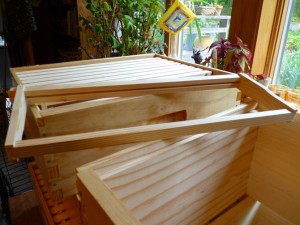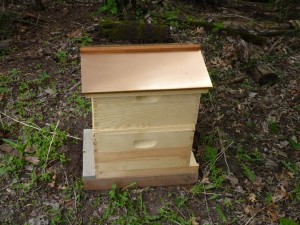Beltane Waxing Planting Moon
I’ve not written about permaculture in a while. The orchard has clover all over, including in some of the plant guilds, but they seem intact. It has changed the view from our kitchen, a productive part of our property now sits just outside our windows. The bees fit in well to the permaculture process because they fertilize the fruits: apples, pears, cherries, blueberries, currants, quince, gooseberries, raspberries and strawberries.
In a modest sense, given the small number of our fruit producing plants, the bee/fruit blossom connection is a complete one. The fruit grows in our soil, blooms here, the bee comes, collects nectar and in the process fertilizes the fruit. The fertilized fruit grows large to encase the fertilized seeds. The bee returns to the hive, uses the nectar and pollen from the fruit blossoms to feed larvae and make honey. When we eat the honey, the circle includes us in a direct and intimate way.
In a similar way the plant guilds, selections of plants that complement each other by warding off predatory insects, attracting beneficial insects, setting nitrogen and micronutrients into the soil, also have a circle of benefit that, in turn, helps us produce healthy vegetables for our table. Our gardens and orchard have a more modest impact on our overall diet than a larger plot could, but the very act of growing and eating at least some of our food makes us more conscious of everything we eat.
There is another strong positive, too, perhaps the most important one of all, at least for me. By working with plants that have specific needs, specific soil temperatures, water requirements, nutrients, length of growing season, protection from pests Kate and I have to orient our lives to their rhythms. No matter what we do, a plant needs to be planted when it needs to be planted. It needs thinning when it needs thinning, pruning when it needs pruning. When harvest comes, it too must be done in a timely manner or the whole process will have gone for not.
The bees, too, have their cycles of birth, maturation and decline. To work with bees we have to take them as they are, not as we would wish them to be. We work with them according to their ancientrails, ones laid down thousands, even millions of years ago and ones to which we adapt, not the other way around.
This act of submission to what could be called biological imperatives does not, surprisingly, chain us, rather, in that wonderfully contradictory way, it frees us to become an active part in nature’s ongoingness. We become an active partner rather than a dominator, yet another living thing dancing to the music of cold and heat, wet and dry, light and dark.
Yes, it is, of course true, that we run our air conditioner in the summer and our furnace in the winter. Yes, we refrigerate some of our food. We close our doors so that we don’t dance to the buzzing and whirring of insects also part of nature’s minuets, gavottes and tangos. So, no, we are not pure, but that is in fact the human dilemma. We are part of nature, able to respond to and participate in her rhythms, yet we are also creatures of culture, the complex web we weave to make our home on this planet.
This tension creates an angst we sometimes know only when we stand on a cliff’s edge, look out toward the ocean and see the sun sink below the water’s blue margin. It is an unresolvable angst, this in but not entirely of nature realm we inhabit. It is, I would argue, an angst that we must embrace, not push away. Why? Because pushing away our delicate problem has created an ecological disaster that just may scour us off the face of mother earth. That’s a good reason, I think.


 boxes and 26 frames. Without her patient and careful craftswomanship, the hives would not exist. I’m just no good at the fine, repetitive tasks involved in woodworking, but she is. She brings an artisan’s hand to her work. As a result we have beautiful hives.
boxes and 26 frames. Without her patient and careful craftswomanship, the hives would not exist. I’m just no good at the fine, repetitive tasks involved in woodworking, but she is. She brings an artisan’s hand to her work. As a result we have beautiful hives.